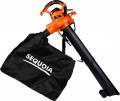Mulching ratio
The ratio of shredding debris provided by a vacuum cleaner with the appropriate mode of operation (see above).
This parameter shows how much the volume occupied by garbage decreases after passing through the grinder. For example, the value "8:1" corresponds to a reduction of 8 times. These figures, of course, are quite approximate, because. in fact, much depends on the type of waste, and in different cases, the indicators will also be different. For example, bulky large branches are “packed” very tightly, and soft leaves initially take up relatively little space, and for them the difference in volume before and after the chopper may be small. Nevertheless, the claimed values quite reliably describe the capabilities of the vacuum cleaner for processing the collected garbage.
Garden vacuum cleaners with a grinding ratio of 1:10 can be classified as average; lower rates are typical for relatively modest models, larger ones for advanced ones.
Motor power
Power of the garden vacuum cleaner motor, expressed in watts. This unit is by far the main one, it is used for both electric and gasoline engines (see "Engine type").
The
more powerful the motor — the more air the vacuum cleaner is able to pass through itself, the greater the speed it is able to give the air flow and the more efficient the chopper (if there is one at all — see "Operating mode"). At the same time, all these moments depend not only on power, but also on many other design features; and manufacturers select each motor in such a way as to provide the vacuum cleaner with certain performance characteristics. Therefore, when choosing, it is worth looking primarily at practical characteristics (flow rate, blowing and suction performance), and engine power is of secondary importance.
Noise level
The noise level generated by the vacuum cleaner during normal operation. The lower this indicator, the more comfortable it is to work with the unit, the less the operator gets tired; and high noise levels may require the use of protection (e.g. earmuffs).
When assessing the noise level, note that the decibel used to measure this level is a non-linear quantity. Therefore, it is easiest to evaluate specific values using comparative tables. Here is one of the variants of such a table (rather simplified):
— 60 dB — sound comparable to a TV at medium volume. From this value, the indicators of modern garden vacuum cleaners begin, because. this technique works quite loudly.
— 70 dB — to a truck at a distance of about 8 m;
— 80 dB — traffic noise on a busy street;
— 90 dB — freight train noise at a distance of 8 – 10 m;
— 100 dB — the noise of the demolition hammer;
— 110 dB — indoor rock concert
Weight
The total weight of the garden vacuum cleaner. Usually, this paragraph indicates the "net" weight of the unit — with an empty dust container (or even without a dust container at all), without fuel and oil (in models with an internal combustion engine, see "Engine type"), without a battery (in the corresponding devices, also see "Engine type"), etc. This parameter is important primarily for models designed to
be carried "on oneself" — that is, hand-held and knapsack (see "Type").

